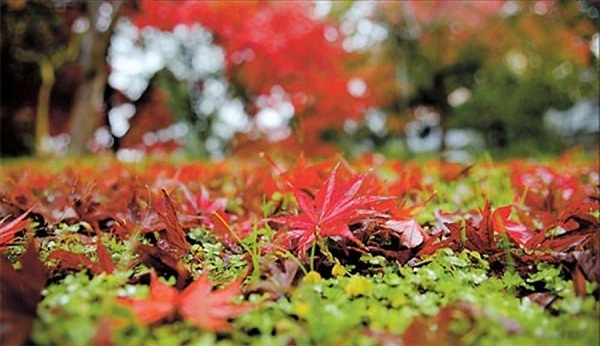Tree leaves are footprints of species
 0 Comment(s)
0 Comment(s) Print
Print E-mail Shanghai Daily, November 26, 2015
E-mail Shanghai Daily, November 26, 2015
|
Colored leaves of the Japanese maple on the ground in autumn.(Yuan Xiao) |
The sudden chill that followed a week of rain isn't reason to despair. The temperature drop has painted the autumn landscape in a bright palette of red and golden leaves.
It may be a reminder that winter is just around the corner, but what a magnificent way to farewell summer. The golden ginkgo and phoenix trees, fire red creepers and sweetgums are sporting splendid foliage that will delight walkers and photographers.
Though the autumn turn is a bit later than usual this year, there's still time to enjoy the seasonal transition, according to Xiu Meiling, a landscape architect at the Shanghai Botanical Garden.
"However, the sudden drop in temperature may shorten the time we have to appreciate autumn splendor," Xiu explained. Persistent rain and wind tend to force trees to drop their leaves more quickly, she said.
The place to view autumn foliage at its best is the Botanical Garden. For over a month, various species of trees will turn red and gold, one after another.
"The taxodiaceae family best represents how the color of the trees changes in the cycle of seasons," Xiu said. "The trees are bright green in spring, blackish-green in summer and golden orange in winter."
One of the most beautiful spots in the garden is the stand of maples that includes Japanese maple, Faber's maple and Shandong maple. Maples are famous for putting on a truly colorful show.
In late fall when most of the leaves have fallen, it's time to look for "smurfberries" — the small red fruit of shrubs, privets and trees that will hang on during the winter months.
"These bright red autumn berries don't wither away on the coldest days, reminding us of the vigor of nature," Xiu said.
The diverse colors of autumn foliage reflect the different pigments of each plant species, explained Xiu. Leaves that change color contain large amounts of chlorophyll, lutein, carotene and anthocyanins.
"Under natural conditions, the chlorophyll is unstable but synthesizes fast, so most leaves are green in spring and summer," she said. "Then in the autumn, the drop in temperature blocks the synthesis of chlorophyll, causing the carotene and anthocyanins to increase, so the leaves turn red, orange and yellow."
Red leaves are the result of long-term growth, the declining interaction of anthocyanins and chlorophyll, and the pH effect of leaf cells. Notable plants with red leaves include creepers, sweetgums, red maples and Chinese tallow trees.
Yellow-colored leaves predominate in ginkgos, pomegranates and the oriental plane tree. They reflect change in the amount of carotene in the leaves.
Creepers are usually the earliest to change color in Shanghai's more humid areas. Defoliation is not far off when red leaves appear, but if the leaves are burned by too much sun in summer, they don't change color.
Japanese zelkova is also among the first species to turn dark red and reddish brown. The foliage on the same tree may show different colors and can be affected by soil conditions and pollution.
Autumn foliage is also related to a tree's age and growth. More mature trees turn color more easily than younger ones, and weaker trees are also more prone to changes.







